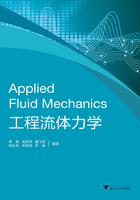
§2.1 Stress characteristics in a stationary fluid
2.1.1 Two characteristics of stress forces in a stationary fluid
Compared with solids and flowing fluid, stress force at arbitrary point of a stationary fluid has two important characteristics:
(1)Surface stress in a stationary fluid is compression stress, i.e.pressure, and the direction of hydrostatic pressure is the same as that of the normal to the action surface.
In a stationary fluid, there is no relative movement between adjacent fluid layers. Thus, there is no shearing force in a fluid at rest.A stationary fluid was split into two parts by N-N'surface.The shaded part was thought of as a detached body.For any point A on the surface of the detached body, the shearing forceτis zero and the degree of angleαis 90 as shown in Fig.2-1.The pressure p is perpendicular to the acting force. Fluids cannot bear tensile stress due to their mobility.Thus, the direction of hydrostatic pressure can only point to its compressed face.It indicates that the surface stress of a stationary fluid can only be compressive stress and the direction is the same as that of the inward normal of the acting plane.

Fig.2-1 Characteristics 1 of stress at any point in a stationary fluid
(2)If a point in a stationary fluid is thought of as an infinitesimally small cube, then it follows the principles of equilibrium that the pressure on every side of this unit of fluid must be equal.Thus, the pressure on a fluid at rest is isotropic; i.e., it acts with equal magnitude in all directions.
This characteristic can be proven as follows:
An infinitesimally small tetrahedron including point O was taken from a fluid at equilibrium as an obj ect of study, and point O was designated as the origin as shown in Fig.2-2.n is the direction of exterior normal of angular surface ABC.Then its force balance was analyzed.

Fig.2-2 Characteristics 2 of stress at any point in a stationary fluid
Firstly, surface force was determined.px, py, pz and pn represent hydrostatic pressure on the three different coordinate surfaces and angular surface, respectively. Because the area of each lateral surface of this tetrahedron is infinitesimal, pressure at all points on the surface is same.Thus, surface force in the direction of x, y, z and n can be represented as  and pn ·dAn(An is the area of angular surface).
and pn ·dAn(An is the area of angular surface).
In addition to the surface force exerted on the tetrahedron OABC, the tetrahedron suffers mass force.The density of fluid is ρ, fx, fy, fz represents the component of unit mass force in the direction of the corresponding coordinate axis.The component of mass force on the tetrahedron in the three coordinate axis is 
 and
and , respectively.
, respectively.
Under the equilibrium conditions, ∑F=0, indicating the sum of the proj ection of its anisotropic component in the x axis is also zero.Thus, in the direction of x axis, we can write

The cos (n, x)represents the cosine of included angle between the exterior normal of angular plane and the positive x axis, and dAn cos (n, x)is the proj ection of dAn in Oy z plane perpendicular to x axis.Therefore,

which was substituted into the equation above, the following equation can be obtained:

The edge-length of tetrahedron tends to zero, and the third term in the equation above also tends to zero.Thus the equation above can be simplified as:
px=pn
In a same way, we can write
py=pn, pz=pn
Thus, it can be concluded:px=py=pz=pn.
The inclined plane was selected at random, suggesting direction n is also arbitrary. Therefore, it can be concluded the pressure on a fluid at rest is isotropic; i.e., it acts with equal magnitude in all directions.The hydrostatic pressure at different points is different and it is a continuous function of position, i.e.p=p(x, y, z).
2.1.2 Inference—pressure in moving fluid and ideal fluid
For real fluid in motion, viscosity results in the generation of shearing forces due to the relative movement between fluid layers.The normal stress is not equal in different direction at the same point.The dynamic pressure of fluid can be determined by averaging three compressive stresses perpendicular to each other, i.e.p= (pz+py+pz).
(pz+py+pz).
However, if the moving fluids are ideal fluids, there is no shearing force.Thus, only compressive stress exists in ideal fluids, and px=py=pz=pn